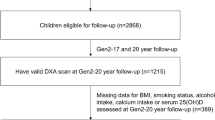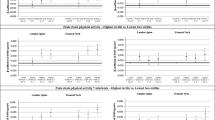Abstract
Summary
Recreational physical activity in 25-year-old women in Sweden increases bone mineral density (BMD) in the trochanter by 5.5% when combining regularity and impact. Jogging and spinning were especially beneficial for hip BMD (6.4–8.5%). Women who enjoyed physical education in school maintained their higher activity level at age 25.
Introduction
The aims of this study were to evaluate the effects of recreational exercise on BMD and describe how exercise patterns change with time in a normal population of young adult women.
Methods
In a population-based study of 1,061 women, age 25 (±0.2), BMD was measured at total body (TB-BMD), femoral neck (FN-BMD), trochanter (TR-BMD), and spine (LS-BMD). Self-reported physical activity status was assessed by questionnaire. Regularity of exercise was expressed as recreational activity level (RAL) and impact load as peak strain score (PSS). A permutation (COMB-RP) was used to evaluate combined endurance and impacts on bone mass.
Results
More than half of the women reported exercising on a regular basis and the most common activities were running, strength training, aerobics, and spinning. Seventy percent participated in at least one activity during the year. Women with high RAL or PSS had higher BMD in the hip (2.6–3.5%) and spine (1.5–2.1%), with the greatest differences resulting from PSS (p < 0.001–0.02). Combined regularity and impact (high-COMB-RP) conferred the greatest gains in BMD (FN 4.7%, TR 5.5%, LS 3.1%; p < 0.001) despite concomitant lower body weight. Jogging and spinning were particularly beneficial for hip BMD (+6.4–8.5%). Women with high-COMB-RP scores enjoyed physical education in school more and maintained higher activity levels throughout compared to those with low scores.
Conclusion
Self-reported recreational levels of physical activity positively influence BMD in young adult women but to maximize BMD gains, regular, high-impact exercise is required. Enjoyment of exercise contributes to regularity of exercising which has short- and long-term implications for bone health.



Similar content being viewed by others
References
Berger C et al (2010) Peak bone mass from longitudinal data: implications for the prevalence, pathophysiology, and diagnosis of osteoporosis. J Bone Miner Res 25(9):1948–1957
Bonjour JP et al (2009) The importance and relevance of peak bone mass in the prevalence of osteoporosis. Salud Publica Mex 51(Suppl 1):S5–S17
Jouanny P et al (1995) Environmental and genetic factors affecting bone mass. Similarity of bone density among members of healthy families. Arthritis Rheum 38(1):61–67
Slemenda CW et al (1991) Genetic determinants of bone mass in adult women: a reevaluation of the twin model and the potential importance of gene interaction on heritability estimates. J Bone Miner Res 6(6):561–567
Eisman JA (1999) Genetics of osteoporosis. Endocr Rev 20(6):788–804
Turner CH (1998) Three rules for bone adaptation to mechanical stimuli. Bone 23(5):399–407
Lanyon LE (1992) Control of bone architecture by functional load bearing. J Bone Miner Res 7(Suppl 2):S369–S375
O’Connor JA, Lanyon LE, MacFie H (1982) The influence of strain rate on adaptive bone remodelling. J Biomech 15(10):767–781
Rubin CT, Lanyon LE (1985) Regulation of bone mass by mechanical strain magnitude. Calcif Tissue Int 37(4):411–417
Nichols DL, Sanborn CF, Essery EV (2007) Bone density and young athletic women. An update. Sports Med 37(11):1001–1014
Nikander R et al (2005) Femoral neck structure in adult female athletes subjected to different loading modalities. J Bone Miner Res 20(3):520–528
Nikander R et al (2009) Targeted exercises against hip fragility. Osteoporos Int 20(8):1321–1328
Kontulainen SA et al (2002) Does previous participation in high-impact training result in residual bone gain in growing girls? One year follow-up of a 9-month jumping intervention. Int J Sports Med 23(8):575–581
Alfredson H, Nordstrom P, Lorentzon R (1996) Total and regional bone mass in female soccer players. Calcif Tissue Int 59(6):438–442
Alfredson H, Nordstrom P, Lorentzon R (1997) Bone mass in female volleyball players: a comparison of total and regional bone mass in female volleyball players and nonactive females. Calcif Tissue Int 60(4):338–342
Nilsson M et al (2010) Association of physical activity with trabecular microstructure and cortical bone at distal tibia and radius in young adult men. J Clin Endocrinol Metab 95(6):2917–2926
Lorentzon M, Mellstrom D, Ohlsson C (2005) Association of amount of physical activity with cortical bone size and trabecular volumetric BMD in young adult men: the GOOD study. J Bone Miner Res 20(11):1936–1943
Daly RM, Bass SL (2006) Lifetime sport and leisure activity participation is associated with greater bone size, quality and strength in older men. Osteoporos Int 17(8):1258–1267
Farr JN et al (2011) Associations of physical activity duration, frequency, and load with volumetric BMD, geometry, and bone strength in young girls. Osteoporos Int 22(5):1419–1430
Trudeau F et al (1999) Daily primary school physical education: effects on physical activity during adult life. Med Sci Sports Exerc 31(1):111–117
Bradney M et al (1998) Moderate exercise during growth in prepubertal boys: changes in bone mass, size, volumetric density, and bone strength: a controlled prospective study. J Bone Miner Res 13(12):1814–1821
French SA, Fulkerson JA, Story M (2000) Increasing weight-bearing physical activity and calcium intake for bone mass growth in children and adolescents: a review of intervention trials. Prev Med 31(6):722–731
Gustavsson A, Thorsen K, Nordstrom P (2003) A 3-year longitudinal study of the effect of physical activity on the accrual of bone mineral density in healthy adolescent males. Calcif Tissue Int 73(2):108–114
Groothausen J et al (1997) Influence of peak strain on lumbar bone mineral density: an analysis of 15-year physical activity in young males and females. Pediatr Exerc Sci 9:159–173
Ainsworth BE, Shaw JM, Hueglin S (2002) Methodology of activity surveys to estimate mechanical loading on bones in humans. Bone 30(5):787–791
Dolan S et al (2006) Development and reproducibility of the bone loading history questionnaire. Med Sci Sports Exerc 38(6):1121–1131
Shedd K et al (2007) Quantifying leisure physical activity and its relation to bone density and strength. Med Sci Sports Exerc 39(12):2189–2198
Weeks BK, Beck BR (2008) The BPAQ: a bone-specific physical activity assessment instrument. Osteoporos Int 19(11):1567–1577
Morel J et al (2001) Bone mineral density of 704 amateur sportsmen involved in different physical activities. Osteoporos Int 12(2):152–157
Bassey EJ et al (1998) Pre- and postmenopausal women have different bone mineral density responses to the same high-impact exercise. J Bone Miner Res 13(12):1805–1813
Kato T et al (2006) Effect of low-repetition jump training on bone mineral density in young women. J Appl Physiol 100(3):839–843
Chilibeck PD, Sale DG, Webber CE (1995) Exercise and bone mineral density. Sports Med 19(2):103–122
Heinonen A et al (1995) Bone mineral density in female athletes representing sports with different loading characteristics of the skeleton. Bone 17(3):197–203
Lee EJ et al (1995) Variations in bone status of contralateral and regional sites in young athletic women. Med Sci Sports Exerc 27(10):1354–1361
Emslander HC et al (1998) Bone mass and muscle strength in female college athletes (runners and swimmers). Mayo Clin Proc 73(12):1151–1160
Fehling PC et al (1995) A comparison of bone mineral densities among female athletes in impact loading and active loading sports. Bone 17(3):205–210
Heinonen A et al (1993) Bone mineral density of female athletes in different sports. Bone Miner 23(1):1–14
Risser WL et al (1990) Bone density in eumenorrheic female college athletes. Med Sci Sports Exerc 22(5):570–574
Neville CE et al (2002) Relationship between physical activity and bone mineral status in young adults: the Northern Ireland Young Hearts Project. Bone 30(5):792–798
Trudeau F, Laurencelle L, Shephard RJ (2004) Tracking of physical activity from childhood to adulthood. Med Sci Sports Exerc 36(11):1937–1943
Kjonniksen L, Anderssen N, Wold B (2009) Organized youth sport as a predictor of physical activity in adulthood. Scand J Med Sci Sports 19(5):646–654
Jose KA et al (2011) Childhood and adolescent predictors of leisure time physical activity during the transition from adolescence to adulthood: a population based cohort study. Int J Behav Nutr Phys Act 8(1):54
Nurmi-Lawton J et al (2004) Evidence of sustained skeletal benefits from impact-loading exercise in young females: a 3-year longitudinal study. J Bone Miner Res 19(2):314–322
Pettersson U et al (2010) Physical activity is the strongest predictor of calcaneal peak bone mass in young Swedish men. Osteoporos Int 21(3):447–455
Hagstromer M et al (2010) Comparison of a subjective and an objective measure of physical activity in a population sample. J Phys Act Health 7(4):541–550
Hagstromer M et al (2010) Levels and patterns of objectively assessed physical activity—a comparison between Sweden and the United States. Am J Epidemiol 171(10):1055–1064
Acknowledgments
This work was supported by grants from the Swedish Research Council (K2009-53X-14691-07-3), FAS (Grant 2007-2125), Grant Greta and Johan Kock Foundation, A Påhlsson Foundation, A Osterlund Foundation, the H Järnhardt Foundation, King Gustav V and Queen Victoria Foundation, Malmö University Hospital Research Foundation, Swedish Centre for Sports Medicine Research, Research and Development Council of Region Skåne, Sweden, and the Swedish Medical Society.
Conflicts of interest
None.
Author information
Authors and Affiliations
Corresponding author
Appendix
Appendix
Rights and permissions
About this article
Cite this article
Callréus, M., McGuigan, F., Ringsberg, K. et al. Self-reported recreational exercise combining regularity and impact is necessary to maximize bone mineral density in young adult women. Osteoporos Int 23, 2517–2526 (2012). https://doi.org/10.1007/s00198-011-1886-5
Received:
Accepted:
Published:
Issue Date:
DOI: https://doi.org/10.1007/s00198-011-1886-5




